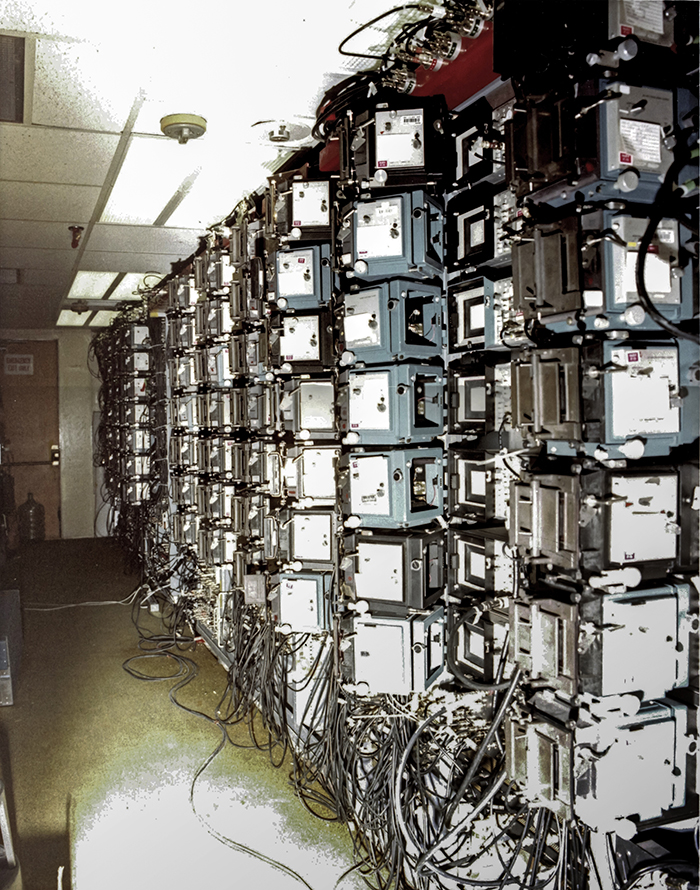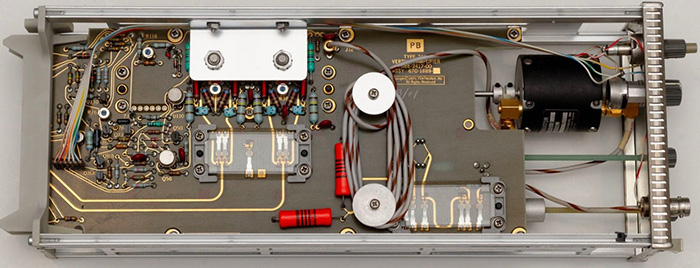This framed photo was donated to the museum by ex-Tek Joe Burger. It is from the Anchorite Nevada nuclear testing site. The trailer had over 100 Tektronix 7903 oscilloscopes on both sides of the trailer. These replaced HP oscilloscopes which were previously installed.

On November 6, 2021, museum volunteers interviewed Joe Burger about this installation. Questions from the volunteers are shown in bold.
You worked on this, the trailer with the box car?
With the rock mount 7903. And the first usage was at the AEC site above Nellis Air Force Base in Nevada. And those scopes showed in the photo are in what they call Anchorite and they replaced HP 283 rack mounts and HP cameras.
This picture (I have the original, and on the back it's signed by Connie Wilson) and the technician for the AEC thanked me for doing those scopes. And you have the photo, I made copies of it here.
And how many instruments are in the picture, or in the trailer?
Well over a hundred. Both sides of that rack and on this side also. You're seeing one side of the bay.
And it was connected to where the underground bomb really was.
It was four inch coax. I first thought it was sheets of black going up over the hill because the sun was hitting it, it was shiny. And then I went inside. They said you no, that's four inch coax.
Goodness.
And that was, the site was very close to the crater that they did when they blew up the A-bomb to simulate what would happen when they wanted to make that bay in Alaska.
Project Plowshare?
I don't know the name, that's what it was when they were going to try to make a bay in Alaska using an atomic weapon. And that is something to see because it's a quarter mile deep, 45-degree sides. It's just something to go down and watch.
And the other thing that was odd is they let me in there and I was not classified. I couldn't go up where Jim Cavoretto's digital scope was in the cave but I could go to where we were.
Okay. So which, the instrument you said was, sacrificed? Was it 7912s?
Yeah, the one Jim Cavoretto, did. It was used in the underground. That's what I was told. I never saw it.
We've heard conflicting things about whether they were sacrificed or whether they were protected by the blast doors.
I was told that by an AEC gentleman.
Well, the Mighty Oak thing was. The equipment was supposed to be behind blast doors and the blast doors failed.
I don't know. I'm surprised when I look back that they even talked to me because I wasn't classified. But I had the original 7904 vertical plug-in, which had that Weischel attenuator in it, David Hannaford found.

They wanted that to take the 7,000 or 10,000 volt pulse that came in before the information they wanted. So I built for the front end of the 7904 a, basically it was zener diodes had big ones, quick, and some other standard diodes to capture that height of that pulse, so the front end could capture the signal.
What is what you're trying about relate to this article by Hale Farley about Tektronix measuring EMP, at a project called Project Trestle (or Atlas, Project Atlas?) using twenty-six 7912s? We've got it on the website here.
Yeah, I have no I have no data on, whatever Jim did, it was classified. And the only data I had is what I said, and that is that probably were vaporized. Now maybe just on that one instance they were vaporized.
So, I'm certainly no expert, but it looks like Hale Farley is describing what we did after that, because he says it was too expensive to keep ruining, you know, blowing up everything that was doing the measurements.
Ok, well that's basically what I was told.
So Project Trestle was what they did after that, in order to simulate what would happen in the event of a bomb.
I don't know.
